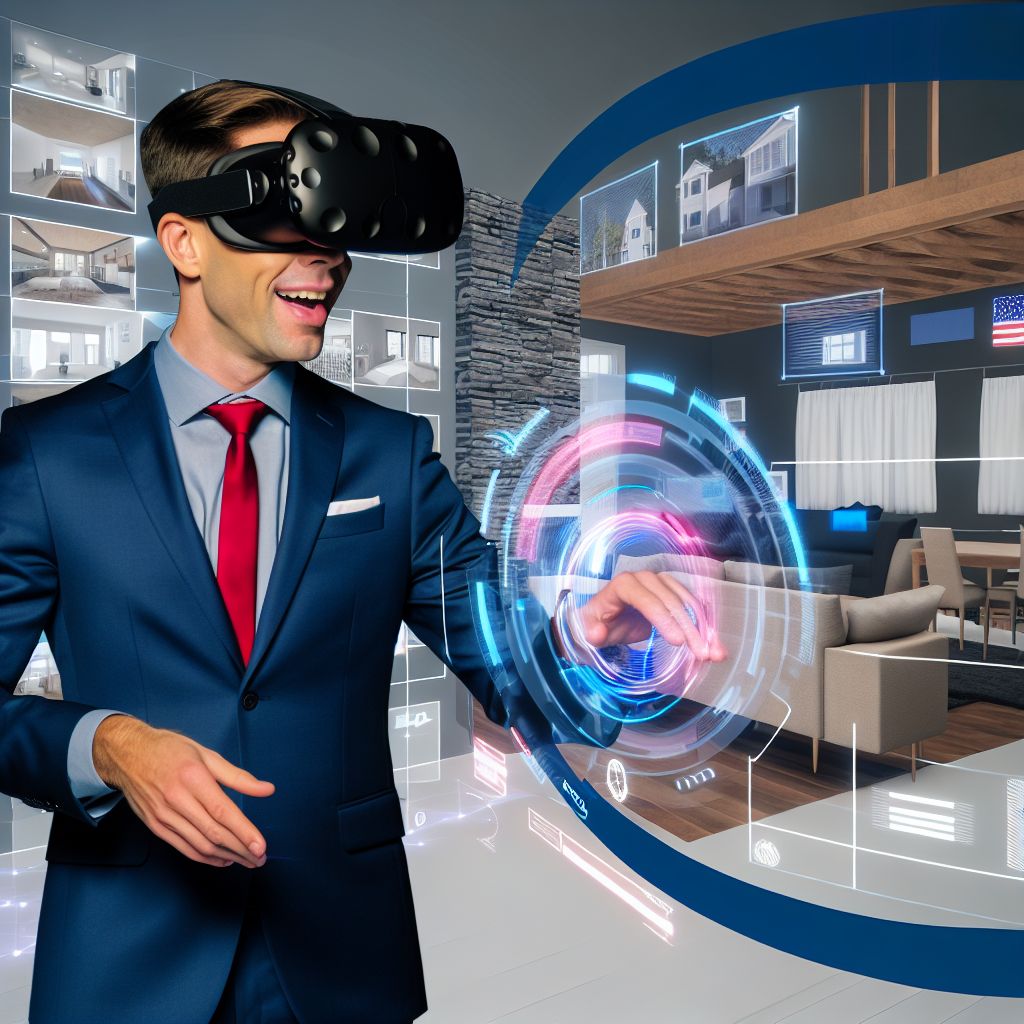Overview of Augmented Reality and its Relevance to Commercial Real Estate
Understanding Augmented Reality
Augmented reality (AR) blends digital content with the real world.
It enhances how users perceive their surroundings.
This technology overlays information onto physical locations.
In recent years, AR has gained popularity across various industries.
It is particularly relevant in marketing, including commercial real estate.
Benefits of AR in Commercial Real Estate Marketing
AR brings several advantages to commercial real estate marketing.
First, it provides interactive experiences for potential buyers.
Users can visualize properties without physical visits.
This feature saves time and resources for both buyers and sellers.
Second, AR enhances property presentations.
Interactive models can showcase properties in greater detail.
This capability helps convey a property’s unique features more effectively.
Enhancing Client Engagement
AR technology increases client engagement in marketing efforts.
Clients can explore properties from the comfort of their homes.
Moreover, AR encourages deeper interactions with the property.
This engagement leads to higher conversion rates for real estate firms.
Real-World Examples of AR Applications
Several companies have already implemented AR in their marketing strategies.
For instance, Immoviewer offers virtual tours through AR applications.
This tool allows users to navigate properties in real time.
Another example is Matterport, which creates 3D models of homes.
These models enable an immersive viewing experience for clients.
Future Trends in AR for Commercial Real Estate
The future of AR in commercial real estate looks promising.
Emerging technologies will continue to improve user experiences.
Integration with virtual reality (VR) could offer further enhancements.
As AR technology evolves, more firms will adopt its applications.
This trend will likely lead to more innovative marketing strategies.
Benefits of Using AR in Commercial Real Estate Marketing
Enhanced Property Visualization
Augmented reality allows clients to visualize properties before construction begins.
This technology brings floor plans to life, providing a dynamic view of spaces.
Moreover, it helps clients understand dimensions and layouts effectively.
As a result, clients make more informed decisions about their potential investments.
Improved Engagement with Potential Clients
AR experiences capture the attention of potential clients immediately.
They create an interactive environment that fosters deeper engagement with listings.
Consequently, clients feel more connected to properties, increasing their likelihood of conversion.
Competitive Advantage
Utilizing AR in marketing offers a significant edge over competitors.
It distinguishes brands in a crowded market by demonstrating innovation.
Additionally, this technology can enhance brand perception as forward-thinking and modern.
Cost and Time Efficiency
Implementing AR can reduce marketing costs in the long run.
It eliminates the need for repeated physical staging of properties.
Furthermore, AR tools streamline the process of showcasing multiple listings.
As a result, agents can save time and resources while reaching a broader audience.
Informed Decision-Making for Buyers
AR technology enhances the decision-making process for buyers.
It provides them with a realistic perspective on properties.
This clarity reduces buyer’s remorse and increases satisfaction post-purchase.
Broadened Audience Reach
AR enables real estate companies to reach a global audience effortlessly.
Virtual tours can attract international investors without requiring physical visits.
Consequently, this opens up new pathways for sales and leasing opportunities.
Key AR Technologies and Platforms Utilized in Real Estate Marketing
Overview of Augmented Reality Technologies
Augmented reality technologies enhance real estate marketing through interactive experiences.
They allow potential buyers to visualize properties in a unique way.
These technologies often use smartphones or AR glasses for immersive experiences.
3D Modeling and Visualization
3D modeling provides detailed representations of properties.
It helps in showcasing both interior and exterior spaces effectively.
Additionally, visualization tools allow users to customize features in real time.
This interactivity makes the property feel more tangible to the buyers.
Virtual Staging Solutions
Virtual staging allows agents to furnish empty spaces digitally.
It enhances the appeal of vacant properties significantly.
This feature helps buyers visualize the potential of a space.
Leading companies in this field include Virtual Staging Solutions and BoxBrownie.
AR Applications for Property Tours
AR applications enable virtual tours of properties from anywhere.
This technology substantially reduces the need for physical showings.
Additionally, it enhances the buyer’s exploration experience.
Popular AR platforms include Zillow and Matterport.
Integration with Real Estate Platforms
Many real estate websites are integrating AR features into their listings.
This makes it easier for buyers to engage with properties online.
Companies like Redfin and Realtor.com are leading the way in these integrations.
They provide comprehensive tools that enhance buyer experiences.
Benefits of AR in Real Estate Marketing
The ultimate goal of these technologies is to increase buyer engagement.
They create immersive and personalized experiences for potential buyers.
Moreover, AR can streamline the decision-making process for buyers.
This technology often results in quicker sales cycles for agents.
Uncover the Details: Land Development for Retail Centers
Case Studies: Successful Implementations of AR in Commercial Real Estate
Transforming the Property Viewing Experience
One notable case is UrbanVista, a tech-savvy real estate firm.
They utilized augmented reality to enhance property tours.
Clients can visualize spaces with 3D furniture placements.
This innovation increased visitor engagement significantly.
Furthermore, it shortened the sales cycle by attracting more buyers.
Enhancing Marketing Campaigns
Skyline Properties launched an AR-driven marketing campaign.
They integrated AR in their advertisements and social media posts.
Users accessed virtual property tours via their smartphones.
This approach boosted inquiries by 40% compared to traditional methods.
Consequently, their brand visibility drastically improved.
Streamlining Project Development
BrightFuture Developments harnessed AR for project presentations.
During client meetings, they showcased developments interactively.
This strategy helped clients understand complex architectural designs.
As a result, project approvals occurred more swiftly.
Stakeholders appreciated the clarity AR provided.
Improving Customer Engagement
Zenith Realty implemented an AR app for prospective buyers.
It allows users to explore properties in real-time using their phones.
Interactive features include customization of living spaces.
Feedback indicates customers feel more connected to properties.
This increases trust and ultimately drives sales.
Future Implications of AR in Commercial Real Estate
The widespread use of AR in this industry is paving the way forward.
More firms are considering AR experiences as essential tools.
As technology advances, expectations will rise.
Real estate professionals must adapt to meet these demands.
The future holds incredible potential for enhanced client interactions.
You Might Also Like: The Future of Sustainable Commercial Real Estate in Urban Areas
How AR Enhances Property Visualization and Customer Engagement
Transforming Property Visualization
Augmented reality revolutionizes property visualization in commercial real estate.
This technology allows potential buyers to view properties remotely.
With AR, clients can experience 3D models of buildings before they are constructed.
This immersive experience helps them envision spaces better.
As a result, buyers feel more connected to properties.
Engaging Customers with Interactive Features
AR applications provide interactive tools that engage customers effectively.
For instance, clients can use their smartphones to see properties in real time.
This feature allows users to navigate spaces easily.
Additionally, they can visualize different design options and layouts instantly.
Such interactions encourage deeper customer involvement in the buying process.
Enhancing Marketing Strategies
AR also enhances marketing strategies in the commercial real estate sector.
Agents can create virtual tours that attract prospective buyers.
These tours can be shared on social media for broader reach.
Moreover, AR promotes listings, making them more appealing and memorable.
This innovative approach ultimately increases lead generation.
Building Trust through Transparency
Using augmented reality fosters transparency between buyers and sellers.
Clients can see accurate representations of properties without physical visits.
This transparency builds trust, as customers feel informed about their decisions.
Additionally, it helps in reducing miscommunications between parties.
Real-Life Success Stories
Many companies have successfully integrated AR into their marketing efforts.
One notable example is Manifold Realty, which utilized AR to conduct virtual showings.
This initiative increased their client engagement significantly.
Similarly, UrbanSpace developed an AR app that allowed users to visualize renovations.
The success of these companies highlights the potential of AR technology.
You Might Also Like: Multi-Family Housing Renovation Tips for Increasing Property Value

Challenges and Limitations of AR Applications in Commercial Real Estate Marketing
Technological Barriers
Many potential users lack access to the necessary hardware and software.
Smart glasses and AR applications often come with a steep price tag.
Consequently, this limits adoption among small businesses and independent agents.
In addition, inconsistent technology standards can complicate integration.
As a result, compatibility issues may arise between devices and platforms.
User Experience Issues
The user experience can vary significantly across different devices.
Some users may find AR overly complicated or not intuitive.
This can lead to frustration and disengagement with the technology.
Moreover, content quality can directly impact user satisfaction.
Poorly developed AR experiences can turn potential clients away.
Data Privacy Concerns
AR applications often collect sensitive user data for functionality.
This raises privacy concerns that can deter potential users.
Organizations must navigate complex data protection regulations.
Consequently, compliance can be challenging and resource-intensive.
Market Acceptance and Education
Despite its potential, AR technology is still gaining acceptance in the market.
Many clients may not fully understand its benefits or applications.
This misunderstanding can hinder sales efforts and marketing initiatives.
Thus, increased education and awareness efforts are necessary.
Industry leaders must actively promote the advantages of AR in real estate.
Content Creation Challenges
Creating high-quality AR content can require extensive resources.
Moreover, the process can be time-consuming and costly.
This often discourages smaller real estate firms from investing in AR.
Additionally, keeping content updated can pose an ongoing challenge.
Static content quickly becomes outdated in a fast-changing market.
Discover More: Multi-Family Housing Market Trends and Investment Opportunities
Future Trends of AR in the Real Estate Industry
Enhanced Property Visualization
Augmented reality will continue to transform property visualization.
This technology allows potential buyers to experience spaces virtually.
In the future, users will likely explore properties in 3D environments.
Potential clients can visualize different design layouts effortlessly.
Furthermore, AR applications will provide customizable features to enhance engagement.
Improved Client Interaction
As AR technology evolves, client interactions will become more immersive.
Real estate professionals will leverage AR for virtual open houses.
This capability provides an interactive experience for prospective buyers.
Agents will gain instant feedback on property preferences through AR tools.
Moreover, AR can facilitate personalized tours to meet unique client needs.
Integration with AI Solutions
The combination of AR and AI will drive innovative solutions in real estate marketing.
AI will analyze user preferences and suggest tailored property options.
This integration will create smarter and more responsive marketing strategies.
Real estate firms could automate personalized communication through AR interfaces.
Consequently, businesses can enhance customer satisfaction and retention rates.
Mobile Accessibility
Mobile devices will play a crucial role in the future of AR in real estate.
Potential buyers will use smartphones to access AR features seamlessly.
This convenience will encourage wider adoption among various demographics.
In turn, real estate agents will capitalize on mobile technology for marketing.
Ultimately, this trend will improve accessibility and increase customer engagement.
Sustainable Real Estate Practices
AR will promote sustainable practices within the real estate industry.
Future applications may demonstrate energy-efficient building designs.
These technologies will forecast environmental impacts and resources efficiently.
Real estate firms will benefit from showcasing eco-friendly properties through AR.
This emphasis on sustainability aligns with modern buyer values and preferences.
Best Practices for Integrating AR into Commercial Real Estate Marketing Strategies
Understand Your Audience
Identifying your target audience is critical for effective marketing.
Know their preferences and pain points.
This understanding guides your choice of AR content and features.
Choose the Right Technology
Selecting the proper AR platform is essential.
Evaluate both user-friendliness and compatibility with existing tools.
Research the latest trends in AR technology.
This ensures you stay competitive in the market.
Create Engaging Content
Content should be visually appealing and informative.
Utilize 3D models to showcase properties effectively.
Incorporate virtual tours to provide immersive experiences.
Engaging audio can enhance the user experience.
Promote Interaction and Engagement
Encourage users to interact with the AR content.
Create features that allow potential clients to customize properties.
Using gamification elements can increase user engagement.
Integrate with Other Marketing Channels
Combining AR with social media can amplify your reach.
Utilize email marketing to promote your AR offerings.
Collaborate with influencers in the real estate sector.
Cross-platform integration ensures a seamless user experience.
Measure Success and Adjust Strategies
Establish metrics to evaluate AR marketing effectiveness.
Analyze user feedback and engagement analytics.
Make adjustments based on performance data.
This ensures continuous improvement of your marketing strategy.
Additional Resources
AI Commercial Real Estate Transactions | Alberta Lawyers
With Augmented and Virtual Reality, Tour Your Office Before It’s Built …




